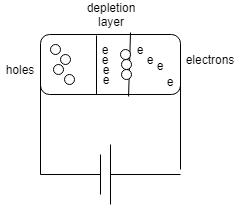
: A hole and electron in close proximity would tend to
A. Repel each other
B. Attract each other
C. Have no effect on each other
D. None of the above
Answer
530.1k+ views
Hint:- Diode, an electrical component that allows the flow of current in only one direction. A diode works on a function of holes and electrons and hence with the forward biasing the depletion layer decreases and in reverse biasing the depletion layer will increase.
Complete step-by-step solution
It is important to understand what is biasing and how holes and electrons work.
Biasing usually refers to how a diode is used in a circuit. If a diode is forward biased, then a small voltage can even cross the depletion and in reverse biased, the voltage at the cathode is higher than that at the anode. Therefore, no current will flow until the electric field is so high that the diode breaks down.
In p-type on semiconductor the impurity is added, and when it is done the holes are created due to the lack of electrons for the bonding. There are many free electrons around and they have a tendency to enter in holes, and this can only be possible if there is an attractive force between the holes and electrons.

This implies that there is an attractive force in between them. As electrons are negatively charged thus the holes are positively charged particles. They tend to attract each other.
Hence option B is correct.
Note:-
When the diode is on, it acts as a short circuit. Ideally, the diode operates as an open nonlinear circuit with a fixed, constant voltage drop. This model is favored in the engineering field due to its simplicity. It is based on the concept that “forward conducting” has a minor fluctuating voltage drop from about 0.6-0.8 volts, with the assumption that the amount of voltage is constant at 0.7V.
Complete step-by-step solution
It is important to understand what is biasing and how holes and electrons work.
Biasing usually refers to how a diode is used in a circuit. If a diode is forward biased, then a small voltage can even cross the depletion and in reverse biased, the voltage at the cathode is higher than that at the anode. Therefore, no current will flow until the electric field is so high that the diode breaks down.
In p-type on semiconductor the impurity is added, and when it is done the holes are created due to the lack of electrons for the bonding. There are many free electrons around and they have a tendency to enter in holes, and this can only be possible if there is an attractive force between the holes and electrons.

This implies that there is an attractive force in between them. As electrons are negatively charged thus the holes are positively charged particles. They tend to attract each other.
Hence option B is correct.
Note:-
When the diode is on, it acts as a short circuit. Ideally, the diode operates as an open nonlinear circuit with a fixed, constant voltage drop. This model is favored in the engineering field due to its simplicity. It is based on the concept that “forward conducting” has a minor fluctuating voltage drop from about 0.6-0.8 volts, with the assumption that the amount of voltage is constant at 0.7V.
Recently Updated Pages
Master Class 12 Business Studies: Engaging Questions & Answers for Success

Master Class 12 Biology: Engaging Questions & Answers for Success

Master Class 12 Physics: Engaging Questions & Answers for Success

Class 12 Question and Answer - Your Ultimate Solutions Guide

Master Class 12 English: Engaging Questions & Answers for Success

Master Class 12 Economics: Engaging Questions & Answers for Success

Trending doubts
Which are the Top 10 Largest Countries of the World?

What is transplantation in agriculture class 12 biology CBSE

Differentiate between homogeneous and heterogeneous class 12 chemistry CBSE

Why is the cell called the structural and functional class 12 biology CBSE

Who discovered the cell and how class 12 biology CBSE

What is the Full Form of PVC, PET, HDPE, LDPE, PP and PS ?




